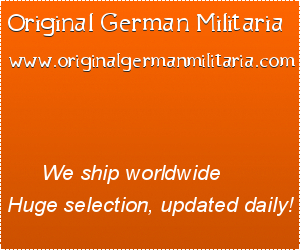Kriegsmarine Truppensonderdienst Oberleutnant equivalent Official Shoulder Boards
SKU: 21.GOR.03.02.02.08.04.008
Estimated market value:

Estimated market value:
Attributes
History
The headgear, uniforms, and insignia worn by members of the Kriegsmarine were based upon the designs utilized by the Kaiserliche Marine (Imperial Navy) and the Reichsmarine of the Weimar Republic. The official regulations governing the uniforms of the Reichsmarine were issued on April 5, 1921, and they were embraced, with a few alterations, as the Kriegsmarine uniforms in 1935.
The first regulations concerning the shoulder boards of officers were issued in 1933, but they were altered several times throughout the interim years and during the war.
Shoulder boards or straps were first and foremost used to identify a soldier’s rank. In certain cases they would also identify the soldier’s branch and unit, and potentially his specific role/career.
Shoulder straps were worn by lower ranks, whereas shoulder boards were worn by higher ranks. The difference lies in the quality of the material, the more elaborate look of the shoulder boards, and the fact that shoulder boards were padded and therefore more stiff, while shoulder straps generally were not. For the sake of simplicity, the terms will be used interchangeably.
Shoulder straps differ in size due to varying production methods and materials, the amount of pips and cyphers they have to hold, and even the wearer’s shoulder size.
The Kriegsmarine shoulder boards were manufactured in three distinct styles, sew-in, slip-on, and pass-through. The boards on the tropical uniform were generally button-on.
The Kriegsmarine used four different uniform types, distinguishable by colour. The shoulder boards will differ from each other depending on what type of uniform they were intended for. The main uniform was navy blue in colour and features shoulder boards with a dark blue underlay. Shoulder boards for the white uniform are very similar, except that they have a white underlay. The brown tropical uniform and the field-grey uniform used mostly by Coastal Artillery units came with shoulder boards that somewhat differed from those of the blue and white uniforms, and will be covered towards the end of this description.
In the Kriegsmarine, shoulder boards were used by soldiers of every rank. An exception were the lowest ranks, the Enlisted Men (EMs), known collectively as Matrosen (seamen), who were only issued shoulder boards with the field-grey uniform and, on occasion, the tropical brown uniform.
In early 1944, the Special Troop Service (Truppensonderdienst) replaced the branch of officials in the Kriegsmarine. There were two branches, administrative and judiciary.
Instead of the silver insignia worn by the officials, members of the Truppensonderdienst now wore gold-coloured insignia, just like the officers they were equal in rank to. An exception were those of ranks equivalent to admirals, which, like the admirals of the Kriegsmarine, wore silver insignia.
Members of the administrative branch wore a mercurian staff as their career insignia cypher. It differed from the regular Kriegsmarine administrative cypher by having an additional bar at the bottom. Their branch colour was cornflower blue. Members of the judiciary corps wore a sword as their career insignia cypher. Their branch colour was crimson. The administrative branch had members with equivalent ranks of Admiral down to Leutnant, while the judiciary corps had members with equivalent ranks of Admiral down to Kapitänleutnant.


Comments
Sign in to comment and reply.


Scroll Top